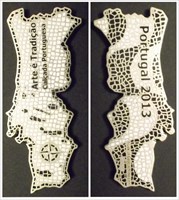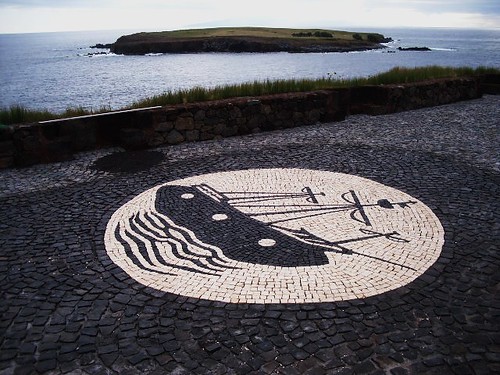This is collectible.


A calçada portuguesa ou mosaico português (ou ainda pedra portuguesa no Brasil) é o nome consagrado de um determinado tipo de revestimento de piso utilizado especialmente na pavimentação de passeios, de espaços públicos, e espaços privados, de uma forma geral. Este tipo de passeio é muito utilizado em países lusófonos.
A calçada portuguesa resulta do calcetamento com pedras de formato irregular, geralmente em calcário branco e negro, que podem ser usadas para formar padrões decorativos ou mosaicos pelo contraste entre as pedras de distintas cores. As cores mais tradicionais são o preto e o branco, embora sejam populares também o castanho e o vermelho, azul cinza e amarelo. Em certas regiões brasileiras, porém, é possível encontrar pedras em azul e verde. Em Portugal, os trabalhadores especializados na colocação deste tipo de calçada são denominados mestres calceteiros.
O facto de a rocha mais comum para estabelecer o contraste seja de cor negra, faz com que se confunda a rocha mais utilizada, o calcário negro, com basalto. De facto, existe calcário de várias cores. O basalto apenas é utilizado nas ilhas, onde é abundante, sendo aí os desenhos executados em calcário branco. Quando é basalto, distingue-se pelo maior mate e pela sua maior irregularidade no corte, pois este é muito mais rijo. Simplesmente não é possível executar com o martelo, os detalhes técnicos dos motivos elaborados presentes na calçada lisboeta.

A calçada à portuguesa, tal como o nome indica, é originária de Portugal, tendo surgido tal como a conhecemos em meados do século XIX. Esta é amplamente utilizada no calcetamento das áreas pedonais, em parques, praças, pátios, etc.
História
Apesar de os pavimentos calcetados terem surgido no reino por volta de 1500, a calçada à portuguesa, tal como a entendemos hoje, foi iniciada em meados do séc. XIX. A chamada "calçada à portuguesa", em calcário branco e negro, caracteriza-se pela forma irregular de aplicação das pedras. Todavia, o tipo de aplicação mais utilizado hoje, desde meados do séc. XX, designado por "calçada portuguesa", é aplicado com cubos, e tem um enquadramento diagonal. Calçada À portuguesa, e calçada portuguesa são coisas distintas.
A calçada começou em Portugal de forma diferente da que hoje é, mais desordenada. São as cartas régias de 20 de Agosto de 1498 e de 8 de Maio de 1500, assinadas pelo rei D. Manuel I de Portugal, que marcam o início do calcetamento das ruas de Lisboa, mais notavelmente o da Rua Nova dos Mercadores (antes Rua Nova dos Ferros). Nessa época, foi determinado que o material a utilizar deveria ser o granito da região do Porto, que, pelo transporte implicado, tornou a obra muito dispendiosa.
FICHA TÉCNICA
- NOME: Geocoin Portugal 2013
- DATA: 2013
- VERSÕES: Regular (RE) em Satin Silver (Preto e Branco) e Limitada (LE) em Black Nickel (4 cores)
- FORMATO: não regular
- TAMANHO: 6,5 cm x 2,76 cm com 3 mm de espessura
- QUANTIDADES: RE: 320, LE: 80
- DESENHO: Miguel Albom
- CONCEÇÃO: Miguel Albom e Flora Cardoso
- PRODUÇÃO: Geocoin Land
- SUPERVISÃO: António Casimiro (acasim)
- rastreável em Geocaching.com, com ícone próprio:
![[Geocoin Icon]](https://www.geocaching.com/images/WptTypes/6887.gif)

Portuguese pavement or Portuguese mosaic (or even Portuguese stone in Brazil) is the consecrated name of a particular type of floor covering used especially in the paving of sidewalks, public spaces, and private spaces, in a general way. This type of tour is widely used in Portuguese speaking countries.
The Portuguese sidewalk is the result of a pair of irregularly shaped stones, usually in black and white limestone, which can be used to form decorative patterns or mosaics by contrasting stones of different colors. The most traditional colors are black and white, although brown and red, gray blue and yellow are also popular. In some Brazilian regions, however, it is possible to find stones in blue and green. In Portugal, the workers specializing in the placement of this type of sidewalk are called masters "calceteiros".
The fact that the most common rock to establish the contrast is black, makes the most used rock, black limestone, with basalt. In fact, there is limestone of various colors. Basalt is only used in the islands, where it is abundant, and the drawings are executed in white limestone. When it is basalt, it is distinguished by the greater mate and its greater irregularity in the cut, because this one is much more hard. It is simply not possible to perform with the hammer the technical details of the elaborate motifs present on the sidewalk of Lisbon.

The Portuguese sidewalk, as the name indicates, originated in Portugal, having emerged as we know it in the mid-nineteenth century. This is widely used in the footing of pedestrian areas, in parks, squares, patios, etc.
History
Although cobbled pavements appeared in the kingdom around 1500, the sidewalk to the Portuguese, as we understand it today, began in the middle of the century. XIX. The so-called "Portuguese sidewalk", in white and black limestone, is characterized by the irregular shape of the stones. However, the type of application most used today, since the mid- XX, called "Portuguese sidewalk", is applied with cubes, and has a diagonal framing. Calçada Portuguese, and Portuguese sidewalk are different things.
The sidewalk began in Portugal differently from the one that is today, more disorderly. The Royal Letters of August 20, 1498 and May 8, 1500, signed by King D. Manuel I of Portugal, mark the beginning of the cobbled streets of Lisbon, most notably Rua Nova dos Mercadores (once Rua New of the Irons). At that time, it was determined that the material to be used should be the granite from the Porto region, which, by the transportation involved, made the work very expensive.
DATASHEET
- NAME: Geocoin Portugal 2013
- YEAR: 2013
- VERSIONS: Regular (RE) in Satin Silver (Black and White) and Limited (LE) in Black Nickel (4 colors)
- SHAPE: not regular
- SIZE: 6,5 cm x 2,76 cm with 3 mm thickness
- QUANTITIES: RE: 320, LE: 80
- ART: Miguel Albom
- CONCEPTION: Miguel Albom and Flora Cardoso
- PRODUCTION: Geocoin Land
- SUPERVISION: António Casimiro (acasim)
- trackable at Geocaching.com, with its own icon:
![[Geocoin Icon]](https://www.geocaching.com/images/WptTypes/6887.gif)
